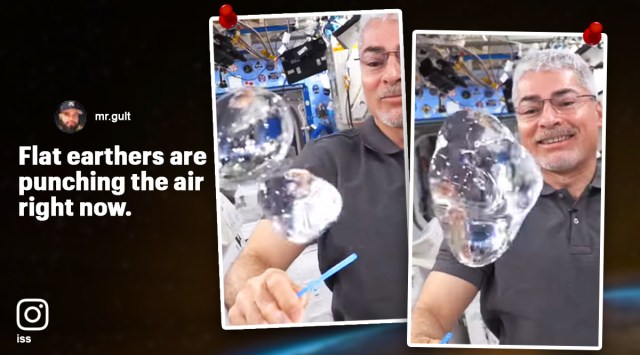This video of water spheres bouncing off in microgravity is enthralling netizens
In the video, two free-floating crystal clear spheres of water bounce off each other after a researcher of the Ring Sheared Drop (RSD) investigation team attempts to bring them together.
 Water spheres bounce off together in space
Water spheres bounce off together in spaceThe International Space Station (ISS) often amazes netizens with its videos on microgravity experiments. This time, the ISS has wowed astronomy lovers with a clip showing free-floating spheres of water in space.
In the video, two free-floating crystal clear spheres of water bounce off each other after a researcher of the Ring Sheared Drop (RSD) investigation team attempts to bring them together. Amazed by the reaction, he is heard saying, “it bounced together.”
Then he adds more force into one of the spheres after which they fuse into one each and unite sans any particular shape. After a while, the researcher blows air into the droplet. Then he adds water inside the air bubble resulting in tiny droplets bouncing inside the air bubble.
“A space station Delta Faucet experiment used microgravity to evaluate water drop formation and flow from a showerhead to create better performance, improve user experience, and conserve water and energy,” ISS said in the post.
Watch the video here:
View this post on Instagram
ISS said in the post that RSD researchers developed a device that uses surface tension rather than a solid container to hold liquids in microgravity. Taking advantage of microgravity in space, scientists can gain new insights into diseases. For investigating certain diseases on earth, researchers must contend with the forces of gravity and the interaction between liquids and containers, the post added.
NASA said on its website that the device was used to study protein aggregates called amyloid fibrils in the RSD experiment. Amyloid fibrils may be related to diseases such as Alzheimer’s, Parkinson’s, and type 2 diabetes. The experiment confirmed that the surface tension concept of RSD works for containing protein solutions in space.
Netizens were enthralled to watch the video, which has garnered more than 2.5 lakh likes so far. “I could literally play with that for a week straight and not get bored,” commented a user.
- 01
- 02
- 03
- 04
- 05































